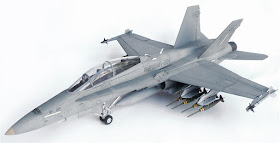From Wikipedia"
The McDonnell Douglas (now Boeing) F/A-18 Hornet is a twin-engine supersonic, all-weather carrier-capable multirole fighter jet, designed to dogfight and attack ground targets (F/A for Fighter/Attack). Designed by McDonnell Douglas and Northrop, the F/A-18 was derived from the latter's YF-17 in the 1970s for use by the United States Navy and Marine Corps.
The Hornet is also used by the air forces of several other nations. It
has been the aerial demonstration aircraft for the U.S. Navy's Flight
Demonstration Squadron, the Blue Angels, since 1986.
The F/A-18 has a top speed of Mach 1.8. It can carry a wide variety of bombs and missiles, including air-to-air and air-to-ground, supplemented by the 20 mm M61 Vulcan cannon. It is powered by two General Electric F404 turbofan engines, which give the aircraft a high thrust-to-weight ratio. The F/A-18 has excellent aerodynamic characteristics, primarily attributed to its leading edge extensions (LEX). The fighter's primary missions are fighter escort, fleet air defense, Suppression of Enemy Air Defenses (SEAD), air interdiction, close air support and aerial reconnaissance.
Its versatility and reliability have proven it to be a valuable
carrier asset, though it has been criticized for its lack of range and
payload compared to its earlier contemporaries, such as the Grumman F-14 Tomcat in the fighter and strike fighter role, and the Grumman A-6 Intruder and LTV A-7 Corsair II in the attack role.
The F/A-18 Hornet provided the baseline design for the Boeing F/A-18E/F Super Hornet,
a larger, evolutionary redesign of the F/A-18. Compared to the Hornet,
the Super Hornet is larger, heavier and has improved range and
payload. The F/A-18E/F was originally proposed as an alternative to an
all-new aircraft to replace existing dedicated attack aircraft such as
the A-6. The larger variant was also directed to replace the aging F-14
Tomcat, thus serving a complementary role with Hornets in the U.S.
Navy, and serving a wider range of roles including refueling tanker.
The Boeing EA-18G Growler electronic jamming platform was also developed from the F/A-18E/F Super Hornet.
The F/A-18C is the single-seat variant and the F/A-18D
is the two-seat variant. The D-model can be configured for training or
as an all-weather strike craft. The "missionized" D model's rear seat
is configured for a Marine Corps Naval Flight Officer
who functions as a Weapons and Sensors Officer to assist in operating
the weapons systems. The F/A-18D is primarily operated by the U.S.
Marine Corps in the night attack and FAC(A) (Forward Air Controller (Airborne)) roles.
The F/A-18C and D models are the result of a block upgrade in 1987 incorporating upgraded radar, avionics, and the capacity to carry new missiles such as the AIM-120 AMRAAM air-to-air missile and AGM-65 Maverick and AGM-84 Harpoon air-to-surface missiles. Other upgrades include the Martin-Baker NACES (Navy Aircrew Common Ejection Seat), and a self-protection jammer. A synthetic aperture ground mapping radar
enables the pilot to locate targets in poor visibility conditions. C
and D models delivered since 1989 also have improved night attack
abilities, consisting of the Hughes AN/AAR-50 thermal navigation pod, the Loral AN/AAS-38 NITE Hawk FLIR (forward looking infrared array) targeting pod, night vision goggles, and two full-color (formerly monochrome) multi-function display (MFDs) and a color moving map.
In addition, 60 D-model Hornets are configured as the night attack F/A-18D (RC) with ability for reconnaissance. These could be outfitted with the ATARS electro-optical sensor package that includes a sensor pod and equipment mounted in the place of the M61 cannon.
Beginning
in 1992, the F404-GE-402 enhanced performance engine, providing
approximately 10% more maximum static thrust became the standard Hornet
engine.
Since 1993, the AAS-38A NITE Hawk added a designator/ranger laser,
allowing it to self-mark targets. The later AAS-38B added the ability to
strike targets designated by lasers from other aircraft.
Production of the F/A-18C ended in 1999. In 2000, the last F/A-18D was delivered to the U.S. Marine Corps.







In the meantime you can have a look at some great F-18 photos :
ReplyDeleteF-18 Super Hornet Pictures